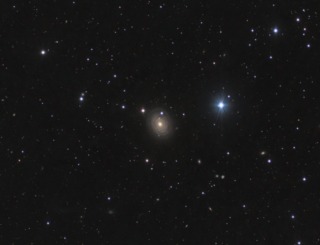
- Constellation: Pisces
- Right Ascension: 01h 21m 46.8s
- Declination: +15° 24′ 19″
- Distance: 90 million ly
NGC 488 a nearly face on spirally spiral galaxy with it's tightly wound arms located 90 million light years away in Pisces. Estimated size of the diameter of the galaxy is 170,000 light years across. Many background galaxies are also visible. The galaxy itself is rather isolated other than a few dwarf galaxies around it.
- Details
- Category: Galaxies
- Telescope: Explore Scientific 127 Refractor
- Camera: ZWO 1600 MM
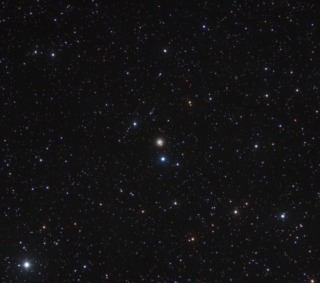
- Constellation: Cassiopeia
- Right Ascension: 00h 52m 04.3s
- Declination: +47° 33′ 02″
- Distance: 39 million ly
Compact isolated face on spiral galaxy located in Cassiopeia. The galaxy is undergoing a burst of star formation in an inner ring but it does not extend out to the outer parts of the galaxy. It is thought to have been caused by a recent merger with a smaller galaxy.
- Details
- Category: Galaxies
- Telescope: Explore Scientific 127 Refractor
- Camera: ZWO 1600 MM
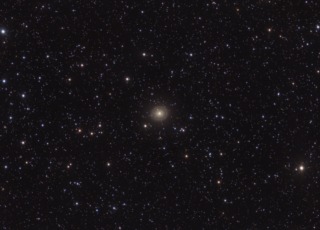
- Constellation: Pegasus
- Right Ascension: 22h 07m 52.4s
- Declination: +31° 21′ 33″
- Distance: 50 million ly
NGC 7217 a gas poor spiral galaxy located in Pegasus 50 million light years away. Three ring like structures where most of the star formations is occurring. Possibly a result of a past galaxy merger as some stars are moving in opposite directions.
- Details
- Category: Galaxies
- Telescope: Explore Scientific 127 Refractor
- Camera: ZWO 1600 MM
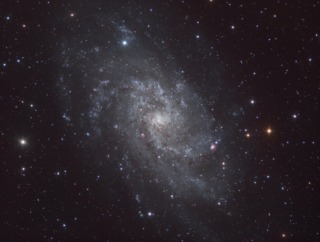
- Constellation: Triangulum
- Right Ascension: 01h 34m 33.2s
- Declination: +30° 47′ 06″
- Distance: 2.7 million ly
Messier 33 or the Triangulum Galaxy located conveniently in the constellation of Triangulum is a member of our local group of galaxies. The third biggest of a group that includes the Milky Way and the Andromeda Galaxies. A spiral galaxy that is approximately 2.7 million light years away. Smaller than the Milky Way, it contains some 40 billion stars compared to the 400 billion plus stars of the Milky Way galaxy.
Numerous HII regions can be seen located in the galaxy as pinkish red sections, the largest is NGC 604 which is amoung the largest HII regions in our local group. It would be over 40 times the size or our Orion Nebula.
- Details
- Category: Galaxies
- Telescope: Explore Scientific 127 Refractor
- Camera: ZWO 1600 MM
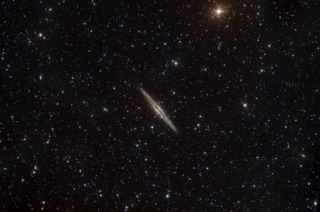
- Constellation: Andromeda
- Right Ascension: 02h 22m 33.4s
- Declination: +42° 20′ 57″
- Distance: 27 million ly
NGC 891 galaxy is located in Andromeda. Similar in size and shape to our galaxy, it's what ours would look like viewed edge on. Fingers of dust and gas are seen extending above and below the galaxies disk, possibly cause by past supernovas expelling gas and dust.
- Details
- Category: Galaxies
- Telescope: Explore Scientific 127 Refractor
- Camera: ZWO 1600 MM
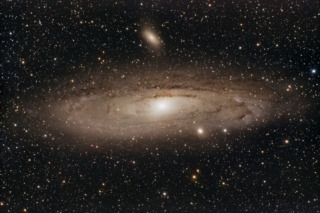
- Constellation: Andromeda
- Right Ascension: 00h 42m 44.3s
- Declination: +41° 16′ 9″
- Distance: 2.5 million ly
Messier 31 or the Andromeda Galaxy, located in the constellation of Andromeda contains more than one trillion stars. Also visible are Messier 110 above the galaxy, and Messier 32 just below the galaxy disk. Two of the 14 satellite galaxies around Messier 31. Until 1923 it was debated whether such objects were nebula located in our galaxy or separate galaxies like our own Milky Way galaxy. In 1923 Edwin Hubble identified Cepheid variable stars in Messier 31. Cepheid variables have a well defined brightness to variability period that allows astronomers to measure distance to them by knowing their actual brightness. Their distance placed them well outside of our galaxy.
Messier 31 is actually approaching us, and is expected to merge with our galaxy in 4 billion plus years in the future.
- Details
- Category: Galaxies
- Telescope: EDT 80mm Reftactor
- Camera: ZWO A071 Color